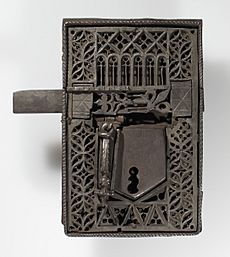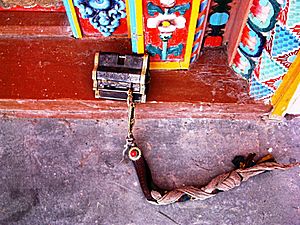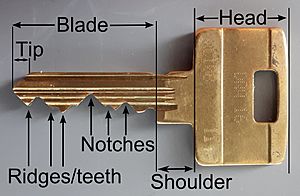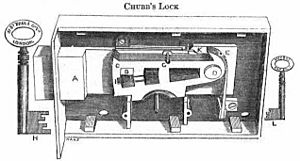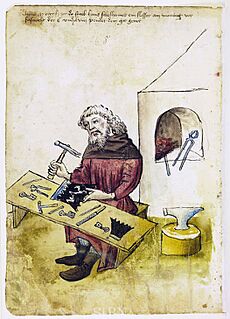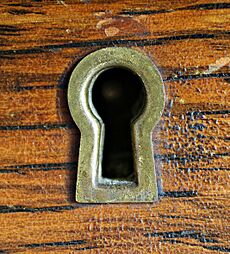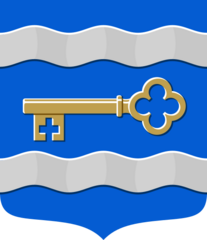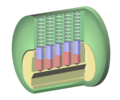Lock and key facts for kids

A lock is a device that helps keep things safe. It can be mechanical or electronic. You need a special item or secret information to open it. This could be a physical key, a keycard, your fingerprint, an RFID card, or a password. Sometimes, a lock can only be opened from one side, like a door chain.
A key is what you use to make a lock work, either to lock it or unlock it. Most keys are small metal pieces. They have a blade that slides into the lock's keyhole and a bow that you hold to turn the key. Usually, one key works for one lock or a group of similar locks.
Keys act like a special pass to a locked area. Locks are designed so only people with the right key can open them and get inside. Some complex locks can be opened by two different keys, one of which is called a master key. Keys are often made from brass, nickel silver, or steel. Trying to open a lock without its key is called lock picking.
Contents
The Story of Locks and Keys

Ancient Locks and Keys
People have used locks for over 6,000 years! One of the first locks was found in the ancient city of Nineveh in Assyria. Later, the Egyptians created a wooden pin tumbler lock. This lock had pins that lifted when a key was put in, allowing the bolt to move. When the key was taken out, the pins dropped, stopping the bolt.
The warded lock also existed a long time ago and is still a well-known design. The first locks made entirely of metal appeared between 870 and 900 AD, created by English craftspeople. Some say the key itself was invented by Theodorus of Samos in the 6th century BC.
The Romans created metal locks and keys. They also developed a security system using wards inside the lock. Wealthy Romans often kept their valuable items in locked boxes at home. They would wear their keys as rings on their fingers. This showed off their wealth and kept their keys handy.
A special type of lock from the 17th-18th century is called a "drunk man's lock." These locks, found in Lier, Belgium, had fancy decorations around the keyhole. Some believe these designs helped people find the keyhole in the dark, but they might have just been for decoration.
Modern Lock Inventions

During the Industrial Revolution in the late 1700s, locks and keys became much more complex. New machines helped make parts more precisely.
In 1778, Robert Barron invented the lever tumbler lock. This lock uses levers that must be lifted to a certain height by the key to open. This type of lock is still used today.
Jeremiah Chubb greatly improved the lever tumbler lock in 1818. After a theft at a naval base, the British Government offered a reward for a lock that only its own key could open. Chubb created the Chubb detector lock. This lock had a special feature that would show if someone had tried to pick it. Chubb won £100 after a skilled lock-picker failed to open it for three months.
In 1820, Jeremiah and his brother Charles started their own company, Chubb. They made many improvements to their locks, like adding more levers and a disc to hide the levers from lock-pickers. They also invented the first burglar-resistant safe in 1835.
Another inventor, Joseph Bramah, created a different type of lock in 1784. His lock used a round key with special notches. These notches moved metal slides inside the lock into the perfect position to open it. Bramah believed his lock was impossible to pick. He even offered £200 to anyone who could open his "Challenge Lock." This challenge lasted for 67 years! Finally, in 1851, an American locksmith named Alfred Charles Hobbs managed to open it, but it took him 51 hours over 16 days.
The first patent for a double-acting pin tumbler lock was given to Abraham O. Stansbury in 1805. But the modern version we use today was invented by Linus Yale Sr. in 1848. This lock used pins of different lengths to stop it from opening without the right key. In 1861, his son, Linus Yale Jr., improved this design. He created a smaller, flat key with jagged edges and pins of different lengths inside the lock. This is the design of the pin-tumbler lock still used today. The modern Yale lock is like a more advanced version of the ancient Egyptian lock.
Even with some changes to key designs, most locks today are based on the ideas from Bramah, Chubb, and Yale.
Different Kinds of Locks
- Bicycle lock
- Cam lock
- Chamber lock
- Child safety lock
- Chubb detector lock
- Combination lock
- Cylinder lock
- Dead bolt
- Disc tumbler lock
- Electric strike
- Electromagnetic lock
- Electronic lock
- Lever tumbler lock
- Luggage lock
- Magnetic keyed lock
- Mortise lock
- Padlock
- Pin tumbler lock
- Police lock
- Protector lock
- Rim lock
- Time lock
- Warded lock
Locks with Physical Keys
A warded lock has barriers inside that stop the lock from opening unless the correct key is used. The key has cuts that match these barriers, letting it turn freely. Warded locks are not super secure because a special skeleton key can often open many of them.
The pin tumbler lock uses a set of pins to keep the lock closed. The key has grooves that let it slide into the lock. As the key goes in, its jagged edges (called bittings) lift pins to a certain height. This lines up the pins, allowing the inner part of the lock to turn and open. Some locks have an extra "master pin" that lets master keys open them.
A wafer tumbler lock is similar to a pin tumbler lock. However, each wafer is a single piece, unlike the two-part pins. Wafer locks are cheaper to make and are often used in cars and cabinets.
The disc tumbler lock (also called an Abloy lock) uses spinning discs with slots.
The lever tumbler lock uses levers to stop the bolt from moving. When the key lifts the levers to the right height, the bolt can slide. These locks are often found inside wooden doors or on older padlocks.
A magnetic keyed lock uses magnets in the key to work the lock. The magnets in the key push or pull tiny parts inside the lock to release it.
Locks with Electronic Keys
An electronic lock uses electricity and is often connected to a system that controls who can enter. Besides pins and tumblers, electronic locks connect the dead bolt or cylinder lock to a motor inside the door. Here are some types:
A keycard lock works with a flat card, like a credit card. You swipe or tap the card, and if its information matches, the door opens.
A typical remote keyless system uses a smart key that sends a radio signal. The lock usually accepts a unique code each time. The smart key sends a different "rolling code" every time you press the button. You can often open car doors with either the remote or a regular key. Car ignition switches might need a transponder car key that both turns a physical lock and sends a radio code.
A smart lock is an electronic lock that gets commands to lock or unlock from a special device, like a smartphone. It uses a digital key and wireless signals. Smart locks are becoming popular in homes and offices because they allow keyless entry. Also, electronic locks cannot be picked with traditional tools.
What is Locksmithing?
Locksmithing is a traditional job. In many countries, you need to complete special training to become a locksmith. Locksmiths can work in shops, travel to customers, or work for big organizations. Some specialize in car locks, master key systems, or safes. Many also give advice on security.
In the past, locksmiths built or fixed entire locks, including all their parts. Now, most locks are mass-produced, so locksmiths usually replace broken parts. However, they still often repair high-security safes. Many locksmiths also work on other door parts like door closers and hinges. They can also make keys for cars with special electronic chips and set up electronic access systems.
While making and replacing keys is still important, modern locksmiths mostly install high-quality locks. They also design and manage key systems for buildings. Locksmiths often figure out how much risk a place has and then suggest the best locks and security rules to keep it safe from intruders.
Making Copies of Keys
Making copies of keys, or key cutting, is usually done by grinding a flat, blank key to match the shape of an original key. Here's how it generally works:
- The original key is placed in a special machine. A blank key is placed next to it in a linked holder.
- A guide follows the shape of the original key. As it moves, the blank key moves against a spinning cutting wheel, copying the original's shape.
- After cutting, the new key is cleaned to remove any sharp metal bits.
Newer key cutting machines can scan the original key electronically. This information is saved and then used to guide the cutting wheel. This means key shapes can be stored and copied by anyone with access to the digital design.
Key copying services are available at many hardware stores and from locksmiths. You can also find online services that duplicate keys.
What is a Keyhole?
A keyhole is the hole in a door or lock where you put the key. Keyhole shapes are very different depending on the lock maker. Many companies have unique keyhole shapes that need a specific blank key to work with the lock's inner parts.
Keys in Symbols and Art
Keys in Symbols
Keys appear in many symbols and coats of arms. The most famous example is the Coat of arms of the Holy See (the Pope's official symbol). This comes from a Bible verse that promises Saint Peter, the first Pope, the Keys of Heaven. You can find many other examples of keys in symbols on Wikimedia Commons.
-
The Coat of arms of the Holy See.
Keys in Artwork
Some artworks connect keys with the Greek goddess of witchcraft, Hecate.
The Palestinian Key

The Palestinian key is a symbol for Palestinians. It represents the homes they lost in the Nakba (meaning "catastrophe") in 1948. During that time, many Palestinians left or were forced from their homes and were later not allowed to return. Since 2016, a Palestinian restaurant in Doha, Qatar, holds the Guinness World Record for the world's largest key. It weighs 2.7 tonnes and is 7.8 by 3 meters big!
See also
- Door security
- Exit control lock
- Key relevance
- Physical security
Images for kids


